![]()
![]()
![]()
Use LEFT and RIGHT arrow keys to navigate between flashcards;
Use UP and DOWN arrow keys to flip the card;
H to show hint;
A reads text to speech;
34 Cards in this Set
- Front
- Back
|
1. Explain why animal welfare is an area of concern 2. Explain the link between welfare and production 3. Provide examples of how animal welfare can be measured during research projects 4. Describe an experiment done to evaluate the effect of castration methods, with or without pain mitigation on acute and chronic indicators of pain. 5. Explain how issues such as temperature, shrink, driver experience and animal type can impact beef cattle welfare during transport. |
Class concepts |
|
|
Why do we care about welfare? |
- we have a moral obligation to treat animals humanely - relationship of welfare to animal health, food quality, and safety - public concern for animal welfare |
|
|
Evidence that consumers are more aware and vocal about food safety and conditions in which their food is raised |
- 62% of survey respondents favoured mandatory labelling of animal welfare practices - U.S shoppers are willing to pay 20% higher prices for products to obtain this type of mandatory labelling information - Canadian Consumer Report: animal welfare is the #1 emerging consumer trend (2010) |
|
|
Areas where animal welfare is related to animal production |
compromised welfare = stress response (behaviour and physiological)
stress = immunosuppression. Leads to increased mortality, reduced feed intake and growth
stress = increased pathogen shedding
increased pathogen shedding = increased antibiotic use |
|
|
Things to look at when assessing cattle behaviour |
basically the distant exam we learned in CSkills - tail flicks, foot stomping, vocalization, escape behaviour, panting, and drooling can all indicate stress
|
|
|
physiological changes under stress |
- cortisol (can be measured in blood, saliva, hair) - catacholemines (adrenaline) - substance P (a neuropeptide that is a biomarker of pain) - immune function (WBCs, lymphocytes, neutrophils, haptoglobin) |
|
|
Why is paying attention to how physiological measurements are obtained important? |
- simply handling the animals can cause changes in physiology and behaviour - prior experience - animal genetics - circadian rhythms |
|
|
Common on-farm practices that can impact welfare |
dehorning castration weaning branding handling and transport |
|
|
Results of testing different castration techniques vs. handling with no castration in 6 to 8 month old bulls with pain medication vs. no pain medication |

Castrated bulls with no medication had the highest cortisol levels. Oddly, after 48 hours the non castrated animals had higher cortisol levels.
|
|
|
Feed intake of animals that were banded, surgically castrated, and not castrated 1 and 2 weeks after procedure |
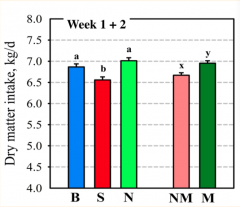
non medicated bulls ate less than medicated bulls. surgically castrated bulls ate the least |
|
|
Average Daily Gains of banded, surgically castrated, and control bulls |
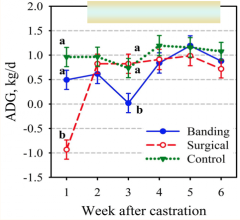
surgical calves had the lowest ADG (0.55) but recovered quicker than banded calves (ADG 0.67). Control had highest ADG (1.01) |
|
|
Final body weight of banded, surgically castrated, and not castrated bulls |

|
|
|
Over the neck temperatures after castration |
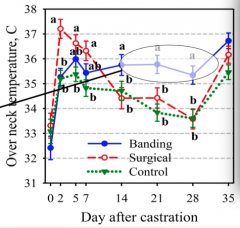
initially highest in surgical calves, but after 2 weeks becomes highest in banded calves |
|
|
Conclusions of castration study |
Both methods (banding and surgical) cause reduced growth rate but feed intake was only affected in surgically treated bulls. - In week 1, pain was worst for surgical but week 3 was worst for banding
Pain mitigation may improve welfare while having economic benefit (improved feed intake, improved final BW, and reduced E. coli shedding) |
|
|
Optimal age to minimize pain and stress of castration |
- as young as possible is best to reduce impacts on growth performance and improve welfare. - young calves have fewer and less severe signs of pain during castration and dehorning - effects of surgical and band castration on a 14 month old bull was so negative that there were no benefits to prolonged testosterone exposure. - there was reduced growth performance in calves castrated at 6-8 months of age vs those castrated at 1 month of age |
|
|
If pain control is to be adopted by industry, drugs and administration strategies must be: |
- readily available and registered for use - effective against pain - easy to administer - long acting - have short withdrawal periods - show return on investment - address public concerns about welfare |
|
|
Things that were looked at in the Transport Benchmark Study |
1. Average minimum and maximum loading densities, transport distances, rest intervals for feed and water, and delay times
2. Number of down, injured , or dead animals
3. If there was a relationship to truck type, driver experience, weather, use of bedding in truck, boarding the sides in winter, and breed, sex, age, or weight class of animals |
|
|
Average delay lengths and reasons for delay |

|
|
|
Average delay time for fat cattle, feeder cattle, and all cattle (overall) |
Fat Cattle: average delay time of 2.1 hours. Max delay length was 19 hours
Feeder Cattle: average delay time of 6.6 hours. Max delay length was 20 hours
All cattle: average delay time of 3.3 hours. Max delay time of 15 hours |
|
|
Time spent of truck for fat cattle (start of loading to end of unloading) |
Average: 15.8 hours Min: 4.5 hours Max: 56.7 hours |
|
|
Time spent of truck for feeder cattle (start of loading to end of unloading) |
average: 22.4 hours min: 4.1 hours max: 44.8 hours |
|
|
Time on the truck for all cattle |
average: 15.9 hours min: 4 hours max: 45.2 hours |
|
|
Shrink (loss of % body weight) in fat cattle |
average: 4.9 min: 0.03 max: 16.5 |
|
|
shrink in feeders |
average: 7.7 min: 0 max: 21.8 |
|
|
shrink in all cattle |
average: 5.3 min: 0 max: 21.8 |
|
|
Relationship between driver experience and shrink |
The more years of experience the driver had, the less shrink on the cattle
0-2 years driving: 5.09% shrink (avg) >10 years driving: 4.86% shrink (avg) |
|
|
relationship between temperature and shrink |
for every 1 degree C rise in temperature, shrink increased 0.04% |
|
|
relationship between temperature, time on truck, and shrink |
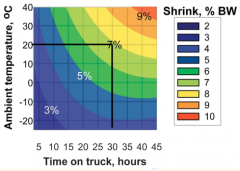
the colder the temperature and less time the cattle spend on the truck, the less shrink the cattle have |
|
|
Things looked at to assess welfare outcomes of transported cattle |
the number of lame, non-ambulatory, and dead cattle.
Total compromised = lame + non-ambulatory + dead |
|
|
effect of driver experience on welfare |
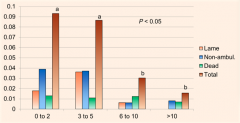
new drivers had a total of about 9.2% bad welfare outcomes. Old drivers had about 1.5%. |
|
|
effect of cattle type on welfare outcomes |
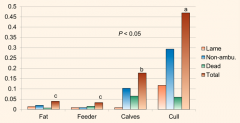
cull cattle had by far the most issues with welfare. This is in part due to issues like old dairy cows being shipped that are not healthy or fit enough for travel |
|
|
how time on truck effects welfare outcomes |

longer time spent on truck results in more lame, dead, and downer cattle |
|
|
effect of temperature on welfare outcomes |
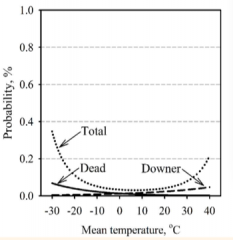
really cold or really hot temperatures had more bad welfare outcomes. Ideal transport temperature for welfare is 0 - 20 degrees |
|
|
effect that space on the truck has on welfare outcomes |
cattle in the belly (the bottom level) of the trailer had welfare issues when there wasn't a lot of space - too squished
cattle in the deck (the top level) of the trailer had welfare issues when there was too much space. The trailer rocks and sways more up high and there's not enough other cattle to lean on so they fall down.
|

